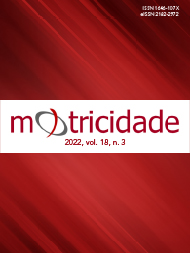The effects of Transcranial Direct Current Stimulation on psychomotor performance of athletes: a systematic review and meta-analysis
DOI:
https://doi.org/10.6063/motricidade.26513Keywords:
psychomotor performance, sports, tDCS, neuromodulationAbstract
Psychomotor performance is a complex function generated by brain and motor systems integration, measured by accuracy, latency, and movement speed. In sports, looking for ways to improve movements is usual. Also, utilising Transcranial Direct Current Stimulation (tDCS) as a non-invasive stimulation technique may produce alterations in psychomotor sports skills. We conducted a systematic review, including experimental studies with sham or control groups in adults reporting tDCS effects on athletes’ psychomotor performance. Cochrane Manual for Systematic Reviews and the statement on systematic reviews and meta-analysis of PRISMA-P (Preferred Reporting Items for Systematic Reviews and Meta-Analyses Protocols) were followed. PsycINFO, PubMed (central), Scopus, Web of Science, Embase, SPORTDiscus, and Cochrane Library databases were searched. Empirical studies published in English, Spanish, and Portuguese from 2009 onwards and whose primary results presented an effective measure of transcranial direct current stimulation in the psychomotor performance of adult athletes were included. The results list 10 articles, 6 of them entered in the meta-analyses. The articles presented a low risk of bias and low publication bias but great dispersion of stimulation areas.
PROSPERO register number: PROSPERO RD42020210550
Downloads
Published
Issue
Section
License
The authors of submitted manuscripts must transfer the full copyright to Journal Motricidade / Sílabas Didáticas Editions. Granting copyright permission allows the publication and dissemination of the article in printed or electronic formats, and copyrights start at the moment the manuscript is accepted for publication. It also allows Journal Motricidade to use and commercialise the article in terms of licensing, lending or selling its content to indexation/abstracts databases and other entities.
According to the terms of the Creative Commons licence, authors may reproduce a reasonable number of copies for personal or professional purposes, but without any economic gain. SHERPA/RoMEO allows authors to post a final digital copy (post-printing version) of the article on their websites or on their institutions' scientific repository.


